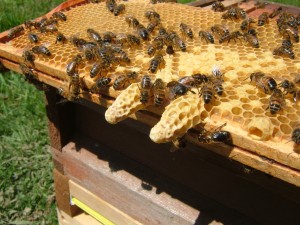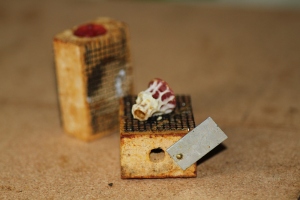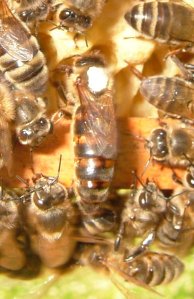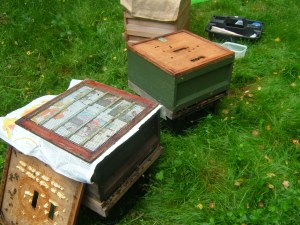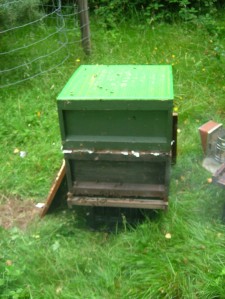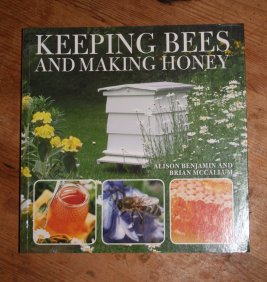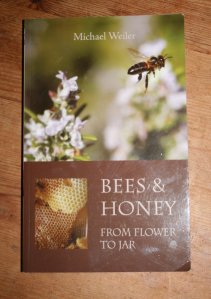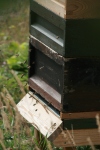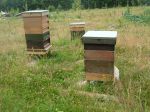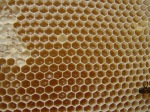Following on from my last blog entry where two of my three honey bee colonies had seemingly lost their queens between the hive inspections in March and those carried out in April I now needed to act reasonably fast if I was going to be able to save either of these colonies. Both of the hives had already been given frames of young eggs taken from my strongest hive, Ogwen, in an attempt to get them to draw out an emergency queen cell, that in turn would lead to a new queen, but this had failed so it was time to try and source new queens elsewhere.
I contacted a couple of local beekeeping suppliers and had replies back to say they would possibly have mated queens by mid-May, I also e-mailed the Kent beekeepers association to see if anyone else locally could help me or offer any advice. Additionally the blog is ‘published’ to Facebook and a few people kindly commented to say that either they had experienced something similar this year or to offer some advice.
I was very fortunate that I received a reply from beekeeper in north Kent, Bob Fitzpatrick, who is having success with the dark art of artificial queen rearing and who also had fresh queens in his hives ready to go. Bob produces bees for a local beekeeping supplier at Bluebell Hill. Like the rest if us his bees have been struggling with the weather this year, and although he has managed to get them to produce the queens, there have not really been many good days for these virgin queens to fly and mate.
A queen bee will attend only one mating flight, early in her life, she flies to a ‘drone congregation area’ where hundreds, or possibly even thousands, of unrelated drones (male bees) are waiting. The drones then pursue the queen and several of them will mate with her whilst still in flight. The queen will store up to 100 million sperm in her oviducts and these will be used to fertilise her eggs for the rest of her life, when she starts to run out she will be replaced. The drones do not survive long after mating as they have served their sole purpose to fertilise a queen.
On Monday morning I drove up to Bob’s house to meet with him and collect two newly hatched queens to deliver back to my now, slightly grumpy, queen-less colonies. These queens were formed after eggs taken from worker comb were grafted into special ‘cups’, the bees then draw these out to form the larger cells that will hold a developing queen and the larvae are then fed a diet of royal jelly rather than the pollen rich diet received by the workers and drones. Once the cells have been drawn out and capped (sealed) they are placed within a small cage so that the new queen hatches in a place where the breeder knows her age and is able to move her into a small hive (nucleus or ‘nuc’) with worker bees to start a new colony.
The queens were given a little fondant for their journey, to prevent the queens chilling the cages were wrapped loosely in newspaper and then they were taken directly to their new hives about an hour away.
You cannot simply open a queen-less hive and drop a new queen in as the existing workers would not accept her and she would be killed. The cages have a small opening in the base for her to escape from but this is partially filled with a soft fondant or candy. The bees have to chew through this fondant from both sides to release the new queen and by the time she is free her royal pheromone has taken control of the colony and she is now in charge!
The weather on Monday improved significantly into the afternoon, but unfortunately the queens would still have been playing Houdini and by the time they had escaped the weather had again declined and the wet windy weather conditions returned. There have a been very few moments of sunshine breaking through since but I do not know if any of these have been long enough for the queens to leave the hive or if these replacement queens will now be stale by the time the warmer weather arrives this weekend.
Before I put the queens into the hives on Monday I checked again to make sure there was definitely no queens present that had just been missed. Snowdon, my first hive, was undoubtedly still without but I have never been to sure about my second, Tryfan. In March there were eggs, larvae and brood present so the queen was definitely in there and laying but by April there was nothing there but also no supercedure cells were formed. I have checked and checked again for the queen in this hive but she was not found and there was no longer any evidence of her. However on Monday the bees in Tryfan seemed to have cleared an area of pollen and stores in the central frames ready for brood rearing and there were now a few eggs in the cells, and certainly not the random or multiple eggs from laying workers. I did not know if these were definitely a new addition and therefore the queen was still present but had stopped laying during the recent cold wet weather (whilst the forager bees have been unable to leave the hive to collect nectar and pollen) or if they were old and abandoned eggs that I had missed under the poor light conditions during the earlier inspections, so I took the gamble and introduced the new virgin queen anyway.
I checked the hives again briefly today (Thursday) and both new queens have escaped their cages, however those eggs I saw last week are now developing larvae meaning they were freshly laid when I saw them and there was a queen present all along, however the introduction of the new virgin queen may have led to her, or the reigning queen, being killed or injured so we are back to a waiting game until the next inspection to see what the outcome is for this colony.
If there are eggs and a marked queen present then my original queen has survived, if there are eggs with an unmarked queen then the new queen successfully mated but if there are no eggs and no queens then I am back to square one, only time will tell.
The other very important influence of the poor weather this year has been the amount of spring feeding required. After an unseasonably warm and sunny March the colonies had built up fast and filled the hives to the seams with young workers all ready for the spring nectar flow but when the cold wet weather set in the now enlarged colonies trapped in the hives have rapidly used up the last of their winter stores. As such the hives have required regular feeding throughout April and into May with a light sugar syrup (1kg sugar to 1 litre water) in order to prevent the bees from starving, it is amazing that my strongest colony can empty a full contact feeder of syrup in about two days so just goes to show what they woudl be using to sustain the colony if they were flying. Feeding this time of year should be done with some caution as it can also encourage the bees to swarm and there seems to be a lot of that starting locally now.
